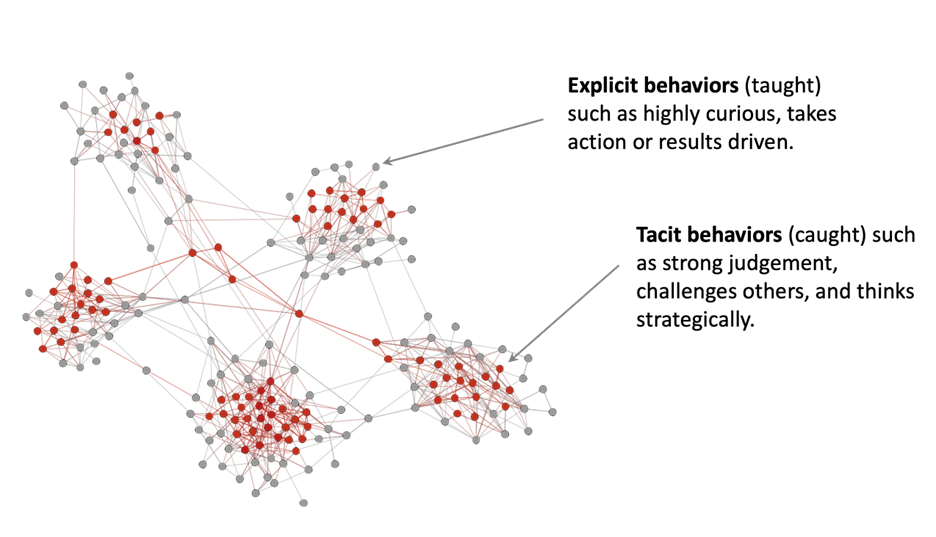Network analysis: Differentiating explicit and tacit behaviors to catalyze culture change
- 5 Min Read
Having analyzed over 1,200 unique working groups or clusters of employees, Michael Arena and colleagues present findings that indicate differentiating between explicit and tacit behaviors can create a more comprehensive and effective approach to driving cultural transformation.
- Author: Michael Arena
- Date published: Jun 29, 2023
- Categories

Organizational culture plays a pivotal role in the success and sustainability of businesses in today’s dynamic environment. A strong, positive culture can propel businesses toward success by driving performance, fostering innovation, and encouraging effective collaboration. Conversely, a weak or toxic culture can lead to disengagement, burnout, and high turnover. Understanding the significance of culture is paramount to long-term organizational success. Our research highlights the challenges of diffusing behaviors within organizations and advocates for a network approach in facilitating effective cultural transformation to ensure that local nuances are managed.
The difficulty of diffusing behaviors
Efforts to diffuse behaviors within an organization often encounter practical challenges. Facilitating culture change and behavior diffusion within an organization is difficult because we often treat all behaviors equally without considering their nuances. We overlook the distinction between tacit and explicit behaviors. This oversight can hinder effective diffusion throughout the organization.
Understanding and addressing these differences are crucial for successful culture change, as it allows for tailored strategies that reinforce tacit behaviors while teaching explicit behaviors. By recognizing and leveraging these nuances, organizations can create a more comprehensive and effective approach to driving cultural transformation.
Tacit behaviors are unspoken and implied actions that are deeply ingrained in a specific cultural context. These are not explicitly taught or explained but rather acquired through observation and participation within a particular community or social group. These are typically acquired through repeated interactions and local modeling. Individuals learn to navigate social situations by observing how others behave and adapting their actions accordingly. Through ongoing exposure and practice, individuals internalize them and they become automatic and second nature.
On the other hand, explicit behaviors are more easily communicated, understood, and taught. They are actions or conduct that are overt, observable, and can be communicated. These are tangible and can be openly taught or trained. They can be clearly defined and articulated through training programs or detailed instructions. This clarity makes it easier to convey expectations and standards to individuals or groups. They also tend to be more generalizable, meaning they can be applied across different situations or contexts. Understanding these nuances is critical to facilitating cultural transformation.
Driving cultural change through network insights
One of the significant benefits of the network approach is its ability to challenge and dispel cultural myths within an organization. For example, all behaviors spread in the same manner across an organization. Network analysis reveals the actual patterns of communication and social connections, often debunking oversimplified assumptions. Armed with these insights, organizations can design interventions to facilitate cultural change.
Using network analysis, we analyzed over 1,200 unique working groups or clusters of employees to better understand how cultural behaviors spread. Most of these clusters were represented by a core group of employees (tightly connected) and employees on the periphery of the cluster (more loosely connected). We also evaluated the individual behavioral strengths from a 360-degree employee assessment to understand behavioral differences. We found that the core exhibited tacit behaviors more strongly, while those on the periphery were more likely to exhibit tacit behaviors.
One example (figure 1) illustrates these findings within a large technology company. The core of network clusters was 2 to 3 times more likely to exhibit tacit behaviors as strengths. Examples included acts with strong judgment, challenging others, and thinking strategically. On the other hand, periphery employees more readily assumed explicit behaviors as strengths. Examples included being curious, operating with speed, and driving results.
 Cultural transformation through behaviors is both caught and taught
Cultural transformation through behaviors is both caught and taught
Understanding the dynamics of explicit and tacit behaviors within an organization is vital for successful culture change. Armed with this knowledge, organizations can design targeted strategies that capitalize on both the explicit behaviors that can be taught on the periphery and the tacit behaviors that are best caught and reinforced within the core. Some are intuitive and easily taught through traditional education methods, while others are more nuanced and require ongoing practice and reinforcement to be fully mastered.
Recognizing the importance of tacit behaviors being caught within the core, organizations can create local modeling, reinforcement, and peer learning opportunities. This can be done by facilitating group cohesion, conducting more after-action reviews, and seeking out coaching moments. By leveraging the power of local interactions and informal connections, organizations can amplify the adoption of tacit behaviors.
Simultaneously, teaching explicit behaviors on the periphery becomes a key component of cultural change efforts. Organizations can provide clear instructions, training programs, and learning opportunities to ensure a collective understanding and alignment across the organization. This promotes a consistent adoption of explicit behaviors and helps shape the overall cultural fabric.
A balanced approach to cultural transformation
A comprehensive strategy for cultural transformation involves a balanced approach. Teaching explicit behaviors through training programs ensures a collective understanding and alignment across the organization. Concurrently, reinforcing the catching of tacit behaviors within the core creates a sustainable and deeply ingrained cultural change. The core and periphery perspectives work in tandem, reinforcing each other and creating a comprehensive cultural change strategy. This approach increases the likelihood of successful adoption, enhances employee engagement and collaboration, and drives overall organizational effectiveness.
________________
Michael Arena is the author of a best-selling book, Adaptive Space: How GM and Other Companies are Positively Disrupting Themselves and Transforming into Agile Organizations. He is the former Chief Talent Officer for General Motors Corporation.








